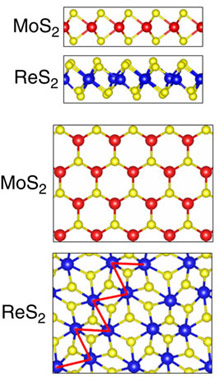
Scientific Achievement
Users at the Molecular Foundry have discovered a new member of the transition metal dichalcogenides (sTMD) family, rhenium disulphide (ReS2), in which the bulk behaves as electronically and vibrationally decoupled monolayers.
Significance and Impact
Monolayer sTMDs are promising functional materials for next-generation flexible optoelectronics and photovoltaics applications but only ReS2 preserves its monolayer properties in the bulk.
Research Details
- When isolated into monolayers, sTMDs feature a direct bandgap – a gap in energy levels that allows the efficient absorption or emission of light.
- Due to weak interlayer coupling, bulk samples of ReS2 perform like independent monolayers and retain the material properties of monolayers.
- Scientists verified the critically important weak interlayer coupling through high-resolution transmission electron microscopy (HRTEM), electron diffraction and density functional theory (DFT) calculations.

